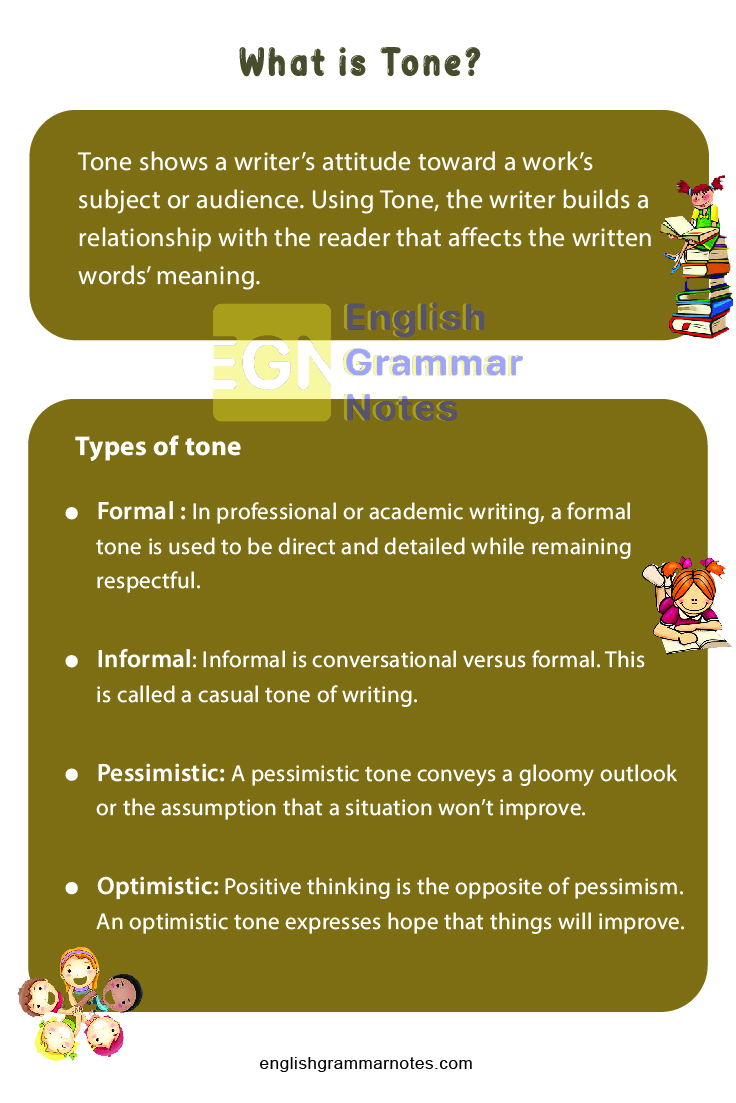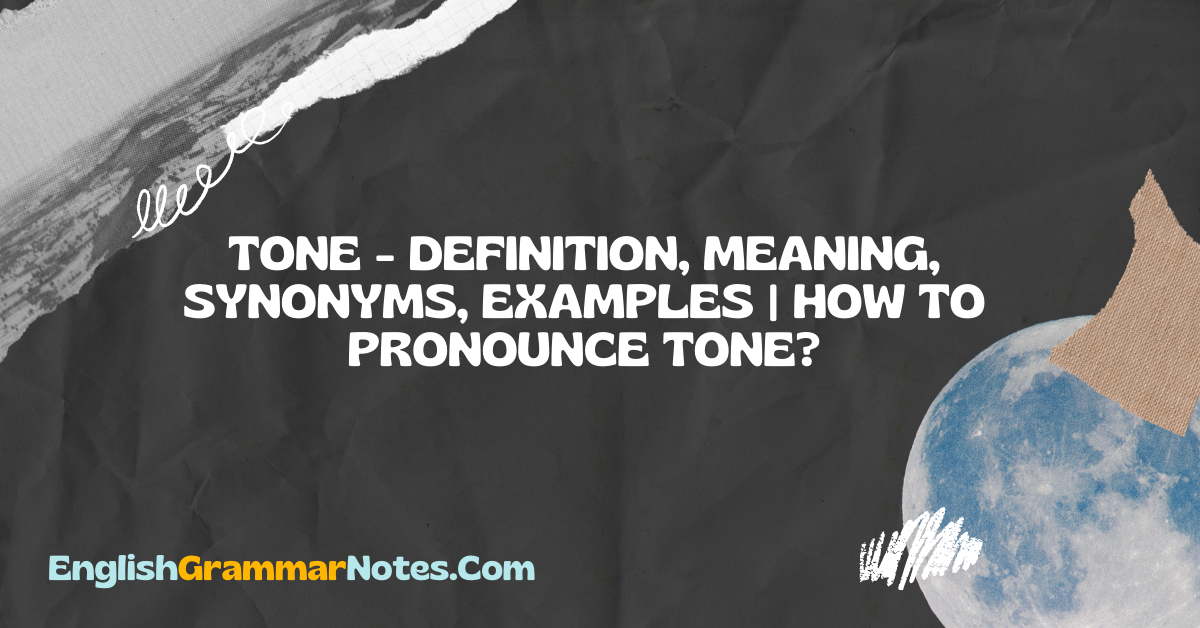A tone is a musical note or a person’s actual or written voice. A newspaper report should be impartial, but a poem can be emotional. His Tone of voice warned me I was in trouble. It can also define a place’s flavor or soul or the shades of meaning in a work that reflect an author’s intentions. Body tone means solid and well-defined muscles. In this article, we are going to discuss What Exactly is Tone, How to Identify Types of Tones in Writing, the Difference between Tone and Mood, and a lot more.
- What is Tone?
- Tone vs. Mood
- What is Tone in Literature?
- Tone Examples
- Types of Tone
- How would you define Tone?
- Please write the types of tones?
- What is the proper way to represent tones in writing?
What is Tone?
Tone shows a writer’s attitude toward a work’s subject or audience. Using Tone, the writer builds a relationship with the reader that affects the written words’ meaning. The writer’s Tone may reflect their attitude or opinion, but this literary method can also convey a character’s or narrator’s emotions. Therefore, readers must critically examine the author’s academic choices to avoid unfairly assigning Tone and interpret Tone judiciously.
Word choice, figurative language, punctuation, and sentence structure express Tone. This helps build a narrative voice, so the reader understands the words and their meanings as intended by the writer, character, or narrator. A clear tone helps readers connect with the author, narrators, and characters.
Tone vs. Mood
Tone and mood are similar literary strategies. Although similar, they serve various goals in academic work. Tone indicates the writer’s point of view, whereas mood conveys a work’s atmosphere and vibe. Figurative language and other literary strategies inspire the mood, while dialogue and descriptions transmit Tone.
Passionate, wistful, nostalgic, and other terms used to define Tone can also be employed to describe the mood. In narratives, a character’s Tone is indicated through dialogue, body language, facial expression, etc. Mood and Tone don’t always match. A writer may set a sorrowful mood through a work’s genre, setting, context cues, and plot specifics, but some characters may be ignorant and have a different conversation.
What is Tone in Literature?
Tone reveals the substance and intent of what readers are reading. It wouldn’t make sense to write straightforward instructions in a wordy, poetic tone or a love poem in a dry, unfeeling tone. Writers establish the Tone of their work to reflect the material and the goal they want it to serve, whether to deliver information accurately, make people laugh, or praise someone.
Tone can also help in the following ways:
⦁ Tone shows a writer’s attitude or ideas regarding their subject.
⦁ A biography of Bill Clinton may be critical of the former president and what he stood for, or it may be praised if the author was a Clinton admirer.
⦁ Tone helps writers mold their readers’ experiences.
⦁ If a writer intends to make readers sad, they may employ gloomy language.
⦁ Similarly, a writer may employ colloquialisms, slang, and ordinary language to create an informal tone.
⦁ Establishing a work’s Tone helps writers convey to readers what the job is trying to accomplish and how it views its subject matter.
Read More:
Tone Examples
We always have an attitude when telling regular stories to others. If someone received flowers from a potential suitor and said, a friend, the person’s story would depend on how they felt about the suitor. If they liked the suitor, the story would be optimistic. The narrative might be told with eye rolls, annoyance, or humiliation if uninterested. Consider these contrasting tones for similar situations:
⦁ “Now that jackass is fired, I won’t have to deal with him anymore.” Vs. Tony was a fantastic coworker; it’s terrible he got fired.
⦁ “Great movie!” I sobbed with laughter! Vs. “Watching infantile humor makes you want to punch yourself in the face.”
⦁ “The principal called to report our son got into a fight. “I can’t believe he did it.” Vs. Billy stood up for himself, and I’m proud. “He deserved it.”
⦁ “I’m glad he phoned!” I’ve been waiting for him. Vs. “Why is that lunatic contacting me again?
Types of Tone
As you study the definition of Tone in writing, look at examples to see how each may appear in your work. Here are some typical categories in which Tone can be subdivided.
Formal: In professional or academic writing, a formal tone is used to be direct and detailed while remaining respectful. Legal writing uses whole words without contractions or slang. Grammatically correct and facts-focused.
Example: The yellow tree frog pairs between April and June, according to research.
Informal: Informal is conversational versus formal. This is called a casual tone of writing. Informal writing may involve slang and contractions. Informal writing sometimes includes more emotion and personal thoughts.
Example: Hello! Do you want to watch a movie with my friends and me tonight?
Pessimistic: A pessimistic tone conveys a gloomy outlook or the assumption that a situation won’t improve. Pessimism isn’t realism, although an author may employ it when feeling negative or wanting to portray an opposing point of view.
Example: I have Cancer and my dog died. I don’t think things will improve soon.”
Optimistic: Positive thinking is the opposite of pessimism. An optimistic tone expresses hope that things will improve.
Example: Despite the social upheaval in my city, I feel I can alter things in my lifetime.

Tense: Tension keeps the reader guessing what will happen next. When writing a mystery or thriller, an author may utilize a tight tone to depict dread. In most stories, the tense Tone resolves, and the Tone changes. A tense tone can make the reader anxious about what’s to follow.
Example: She sought furiously for the killer, who was hiding in the darkness. Moving aimlessly, she worried if she’d find and stop him before he went on to his next victim.
Curios: A curious tone indicates that the author or character wants to learn more or that the reader will discover additional details. Someone might write curiously to seek new facts or describe a small youngster learning about the world. This Tone helps keep readers engaged.
Example: He asked about the sky’s hue, why the birds were flying in a V-shape, and if I would pick him up after his sleep as we drove to school.
Uplifting: An upbeat tone provides confidence to the reader that they can overcome challenges or take new steps in their quest. Self-help authors and motivational speakers use a positive tone.
Example: Jason thought the first day in his new wheelchair would be challenging, but he remembered his mother’s warning to smile. His friends and classmates were glad to push his wheelchair and sit with him, delivering pleasant and supportive remarks.
Aggressive: Aggressiveness can convey irritation or wrath. When writing aggressively, a writer may be unpleasant or unfriendly.
Example: “No, I don’t want to hear another word about it till we die.”
Assertive: Some people mistake assertive for aggressive, but they’re different. A confident, strong tone is more authoritative than an angry, harsh one. When writing assertively, authors are forthright and leave little space for debate.
Example: Her unyielding conviction moved listeners to join the committee and make changes in their neighborhood as she spoke.
Informative: A tone that informs the reader that the content is instructive. Educational resources are informative.
Example: Millions of brain cells handle the body’s operations.
Entertaining: A humorous tone aims to engage the reader. It may be funny or lighthearted and delightful.
Example: Who’s there? Nobel. Oscar? No bell, that is why I knocked.
Sarcastic: Sarcasm shows disdain or mocks another’s viewpoint. Writing sarcasm is difficult since it’s a sort of linguistic irony. Body language and character emotions can convey sarcasm in literature.
Example: Emma rolled her eyes, said, ‘Okay, anything you say goes,’ and walked away.
FAQs on Tone
One’s unique manner of expressing one’s feelings through speech or writing is known as Tone.
2. Please write the types of tones?
Here are the basic ones: Formal. Informal. Optimistic.
3. What is the proper way to represent tones in writing?
Let’s look at some simple yet effective techniques for improving your writing Tone.
⦁ Be wary of falling into the trap of treating your subject like a tired old cliché.
⦁ Maintain a Consistent tone Throughout
⦁ Let the Tension sustain the Tone.
⦁ Use your voice
⦁ Use Specifics to Establish Tone
Conclusion
The Tone is perhaps the most intangible of a work of fiction’s many literary components (topic, tale, character, setting, figurative language, literary devices, etc.). However, the Tone of a book is one of the most distinguishing features that sets it different from others in the fiction genre. To completely grasp how Tone defines literary works, one must first comprehend what Tone is. All the nuances of the term “TONE” have been discussed. We appreciate your visit.
